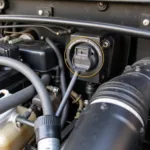One of the most common questions car owners ask is whether OBD2 is the same for foreign cars. The short answer is yes, but there are some important details to keep in mind.
Understanding OBD2: A Universal Standard
OBD2, which stands for On-Board Diagnostics, second generation, is a standardized system that allows external electronics to interface with a car’s computer system. This system was mandated in the United States for all cars manufactured after 1996, regardless of their country of origin. The goal of OBD2 was to create a universal system for diagnosing and monitoring vehicle emissions and performance.
This means that whether you drive a Toyota, a Honda, a BMW, or a Mercedes, your car is equipped with an OBD2 port. This port is typically a 16-pin trapezoidal connector located under the dashboard on the driver’s side.
Slight Variations and How to Navigate Them
While the OBD2 standard is universal, there can be slight variations in implementation between different car manufacturers and models. These variations are mainly in the communication protocols used by the car’s computer system.
For example, some European car manufacturers used their own protocols before the OBD2 standard was widely adopted. However, even these vehicles will typically have an OBD2-compliant port that can communicate using standard protocols.
Here’s what you need to know to ensure compatibility:
- Check your owner’s manual: This will tell you the exact location of your vehicle’s OBD2 port and any specific protocols it might use.
- Consider a professional-grade OBD2 scanner: Top 5 OBD2 Pro Scanners can provide more comprehensive diagnostics and support a wider range of communication protocols.
- Consult a mechanic: If you’re ever unsure about compatibility or encounter issues, a qualified mechanic can help diagnose your foreign car accurately.
 Mechanic Using OBD2 Scanner on Foreign Car
Mechanic Using OBD2 Scanner on Foreign Car
OBD2: Your Key to Understanding Your Foreign Car
Understanding the capabilities of your OBD2 system can significantly enhance your ownership experience. By using an OBD2 scanner, you can:
- Retrieve and interpret diagnostic trouble codes (DTCs): These codes can pinpoint the source of issues with your engine, transmission, emissions system, and more.
- Monitor real-time engine data: Access parameters like engine speed, coolant temperature, oxygen sensor readings, and fuel pressure to get insights into your car’s performance.
- Customize your driving experience: Some advanced scanners allow you to adjust certain vehicle settings, such as the automatic door lock behavior or daytime running lights.
Is OBD2 compatible with my car?
You might be wondering, “Is my car OBD2 compliant?”. Cars manufactured in the United States after 1996 are required to be OBD2 compliant. For OBD2 Supported Vehicles, you can refer to our comprehensive guide for more information.
What do the letters and numbers on my OBD2 reader mean?
The letters and numbers you see on your OBD2 reader are diagnostic trouble codes, often referred to as A T Codes on OBD2 Reader. These codes provide specific information about potential issues with your vehicle’s systems.
Conclusion
In conclusion, OBD2 is largely the same for foreign cars as it is for domestic vehicles. The standardized system provides a valuable tool for understanding your car’s health and performance. By understanding the basics of OBD2 and seeking out the right tools and resources, you can confidently diagnose and address issues with your foreign car.

